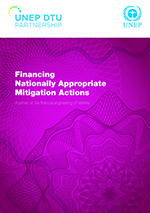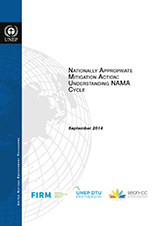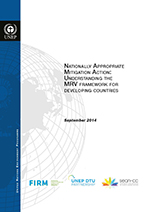September saw the release of three new NAMA publications by UNEP DTU Partnership.
 Financing Nationally Appropriate Mitigation Actions: A primer on the financial engineering of NAMAs explains essential financing principles and models. It highlights challenges in financing NAMA policies and programmes, as well as possible ways to overcome these obstacles.
Financing Nationally Appropriate Mitigation Actions: A primer on the financial engineering of NAMAs explains essential financing principles and models. It highlights challenges in financing NAMA policies and programmes, as well as possible ways to overcome these obstacles.
Authored by Søren E. Lutken, the publication argues that NAMAs should not be designed as a theoretical exercise, considering financing issues in the final phase. The financing model should be factored in at the beginning of the NAMA design process, not at the end.
This new Primer focuses on financing the NAMA itself, as opposed to NAMA preparation. As the booklet focuses on instruments available for public-private interactions, it also explores the dynamics of leveraging.
 Policy makers, private sector and other stakeholders often raise questions about the process cycle for designing and implementing NAMAs. How does one start the NAMA development process? How are NAMAs linked to climate change policies? Who is responsible for various aspects of NAMA development? What is the role of the private sector? Is there a decision making process for considering and approving NAMAs?
Policy makers, private sector and other stakeholders often raise questions about the process cycle for designing and implementing NAMAs. How does one start the NAMA development process? How are NAMAs linked to climate change policies? Who is responsible for various aspects of NAMA development? What is the role of the private sector? Is there a decision making process for considering and approving NAMAs?
Authored by Sudhir Sharma and Denis Desgain, Nationally Appropriate Mitigation Action: Understanding NAMA Cycle aims to address the above questions and give national stakeholders a understandable overview of the entire process cycle, as well as the roles and responsibilities of various actors each step of the way.
While a number of publications address the NAMA design process, these usually focus on either the content of NAMAs, or on stakeholders’ engagement at the national level. This booklet offers a clear rundown of how the overall process works, so that stakeholders know where they are heading when they start designing their NAMA strategy.
The publication was prepared with support from the South East Asia Network of Climate Change Offices (SEAN-CC) and the Facilitating Implementation and Readiness for Mitigation (FIRM) projects.
 The third publication, Nationally Appropriate Mitigation Action: Understanding the MRV framework for Developing Countries, authored by Sudhir Sharma, aims to enhance policy makers’ understanding of Measuring, Reporting and Verifying (MRV) systems, including operational requirements. The publication targets sectoral experts and developing-country NAMA practitioners who are in search of more information on how MRV systems work.
The third publication, Nationally Appropriate Mitigation Action: Understanding the MRV framework for Developing Countries, authored by Sudhir Sharma, aims to enhance policy makers’ understanding of Measuring, Reporting and Verifying (MRV) systems, including operational requirements. The publication targets sectoral experts and developing-country NAMA practitioners who are in search of more information on how MRV systems work.
The publication describes the MRV framework of developing country mitigation actions as agreed by the Parties to the UNFCCC. It then details the most common elements of a MRV system, including institutional arrangements, processes and procedures. Other issues covered include what kind of measurements need to be taken, the role of the NAMA developer in regard to MRV, measurement plans, reporting requirements, and the various types of verification systems. Finally, the publication explains how NAMA implementation is aggregated, presented and reported in Biennial Update Reports (BURs) and other records.
This publication was prepared with support from the South East Asia Network of Climate Change Offices (SEAN-CC) and the Facilitating Implementation and Readiness for Mitigation (FIRM) projects.